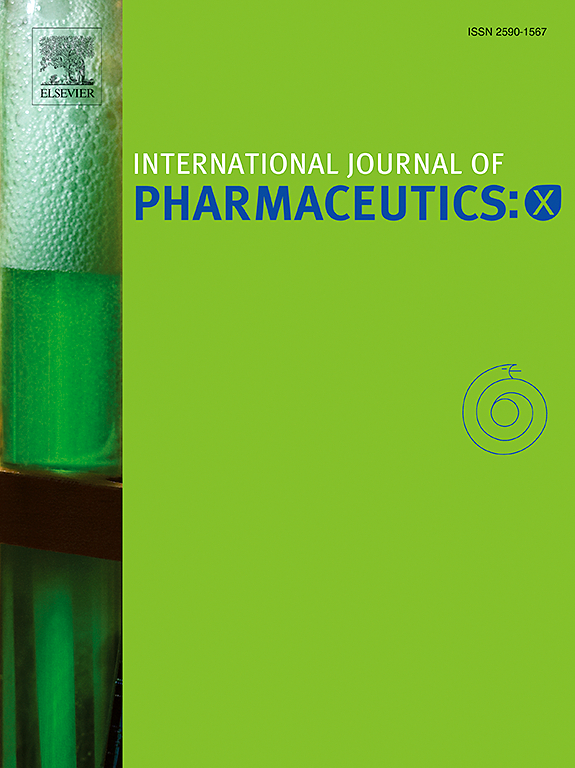通过药物-聚合物溶解度和混溶性的经验和混合模型推进无定形固体分散体:以布洛芬为例
IF 6.4
2区 医学
Q1 PHARMACOLOGY & PHARMACY
引用次数: 0
摘要
本研究通过差示扫描量热法(DSC)实验,结合经验和混合建模方法,研究了布洛芬(IBU)与四种药物聚合物KOLVA64®、KOL17PF®、HPMCAS和Eudragit®EPO的溶解度和混溶性。基于Hildebrand和Hansen溶解度参数(Fedors, Hoftyzer-van Krevelen和Just-Breitkreutz)的传统基团贡献方法在溶解度预测方面表现出可变性,但始终将所有聚合物- api共混物归类为可混相(Δδ <;7 MPa½)。Bagley图强化了这些发现,尽管根据所使用的方法,HPMCAS和EPO显示了临界混溶性。从接近熔融温度下的溶解度参数推导出Flory-Huggins (FH)相互作用参数(χ)的新尝试与实验数据的一致性很差,强调了这种外推的局限性和FH模型的半经验性质。采用三种建模策略:FH理论、Kyeremateng的经验方法(两种拟合方法)和摄动链统计关联流体理论(PC-SAFT)状态方程,分别在纯预测和拟合的二元相互作用参数(kij)下构建基于dsc的熔点下降数据的相图。用Gordon-Taylor和Kwei方程模拟了混合物的玻璃化转变温度(Tg)。所有模型根据其增溶能力提供了一致的聚合物排名,KOL17PF是最相容的,HPMCAS是最不相容的。FH和PC-SAFT模型预测的脱混区(液-液平衡- LLE)表明,对于基于hpmcas的asd,只有非常低的药物负荷(<;5% w/w)可能在室温下稳定。相比之下,更高的药物载量(>;10% w/w)与其他聚合物处于亚稳定区,使其成为IBU配方的更好候选者。HPMCAS在所有Tg模型中也表现出一致的预测误差(AARD ~ 4.5%),表明与实验数据的一致性较差。通过整合经验和混合建模方法,本研究强调了常用溶解度预测方法的优势和局限性,并倡导向协调框架转变。本文章由计算机程序翻译,如有差异,请以英文原文为准。

Advancing amorphous solid dispersions through empirical and hybrid modeling of drug–polymer solubility and miscibility: A case study using Ibuprofen
This study investigates the solubility and miscibility of ibuprofen (IBU) with four pharmaceutical polymers, KOLVA64®, KOL17PF®, HPMCAS, and Eudragit® EPO, using a combination of empirical and hybrid modeling approaches, supported by differential scanning calorimetry (DSC) experiments. Traditional group contribution methods based on Hildebrand and Hansen solubility parameters (Fedors, Hoftyzer–van Krevelen, and Just–Breitkreutz) showed variability in solubility predictions but consistently classified all polymer–API blends as miscible (Δδ < 7 MPa½). Bagley plots reinforced these findings, although borderline miscibility was indicated for HPMCAS and EPO depending on the method used. A novel attempt to derive the Flory–Huggins (FH) interaction parameter (χ) from solubility parameters at near-melting temperatures showed poor agreement with experimental data, underscoring the limitations of such extrapolations and the semi-empirical nature of the FH model.
Phase diagrams were constructed from DSC-based melting point depression data using three modeling strategies: FH theory, the empirical approach by Kyeremateng (with two fitting methods), and the perturbed-chain statistical associating fluid theory (PC-SAFT) equation of state, both in pure predictions and with fitted binary interaction parameters (kij). The glass transition temperature (Tg) of the mixtures was modeled using the Gordon–Taylor and Kwei equations. All models provided a consistent polymer ranking based on their solubilizing capacity, with KOL17PF as the most compatible and HPMCAS as the least. Demixing zones (liquid-liquid equilibrium - LLE) predicted by FH and PC-SAFT models suggest that for HPMCAS-based ASDs only very low drug loadings (< 5 % w/w) could potentially be stable at room temperature. In contrast, higher drug loadings (> 10 % w/w) fall under a meta-stable zone with the other polymers, making them better candidates for IBU formulation. HPMCAS also exhibited consistently prediction errors across all Tg models, (AARD ∼4.5 %), indicating poorer agreement with experimental data. By integrating empirical and hybrid modeling approaches, this study highlights the strengths and limitations of commonly used solubility prediction methods and advocates for a shift toward a harmonized framework.
求助全文
通过发布文献求助,成功后即可免费获取论文全文。
去求助
来源期刊

International Journal of Pharmaceutics: X
Pharmacology, Toxicology and Pharmaceutics-Pharmaceutical Science
CiteScore
6.60
自引率
0.00%
发文量
32
审稿时长
24 days
期刊介绍:
International Journal of Pharmaceutics: X offers authors with high-quality research who want to publish in a gold open access journal the opportunity to make their work immediately, permanently, and freely accessible.
International Journal of Pharmaceutics: X authors will pay an article publishing charge (APC), have a choice of license options, and retain copyright. Please check the APC here. The journal is indexed in SCOPUS, PUBMED, PMC and DOAJ.
The International Journal of Pharmaceutics is the second most cited journal in the "Pharmacy & Pharmacology" category out of 358 journals, being the true home for pharmaceutical scientists concerned with the physical, chemical and biological properties of devices and delivery systems for drugs, vaccines and biologicals, including their design, manufacture and evaluation. This includes evaluation of the properties of drugs, excipients such as surfactants and polymers and novel materials. The journal has special sections on pharmaceutical nanotechnology and personalized medicines, and publishes research papers, reviews, commentaries and letters to the editor as well as special issues.
 求助内容:
求助内容: 应助结果提醒方式:
应助结果提醒方式:


